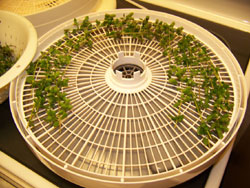Drying
 One of the oldest methods of food preservation is drying. It is simple, safe, and easy to do. Dried foods take up less storage space and do not require refrigeration. The food is lightweight which makes it ideal for camping as well as an anytime snack.
One of the oldest methods of food preservation is drying. It is simple, safe, and easy to do. Dried foods take up less storage space and do not require refrigeration. The food is lightweight which makes it ideal for camping as well as an anytime snack.
Drying removes moisture from the food. This prevents bacteria, yeasts and molds from growing and causing spoilage. Drying also slows enzyme activity in food which can cause color, texture, and flavor changes.
Foods can be dried is several ways. The oldest method is sun drying. Other methods include a food dehydrator or an oven. For best results, a combination of warm temperature, low humidity and air circulation help dry foods properly.
Let's Preserve: Drying Foods at Home
This publication from University of Nebraska-Lincoln provides an introduction to dehydrating foods and freeze drying foods.
Drying Fruits and Vegetables
- Leathers and Jerkies - Colorado State University
- Drying Fruits and Vegetables - University of Georgia
- Vegetable Leathers - University of Georgia
- Drying Foods - New Mexico State University
Meat Jerky
- Dry Meat Safely at Home - Kansas State University
- Secando Carne en Casa en Forma Segura - Kansas State University
- Preparing Safe Jerky - University of Georgia
Other Foods
- Drying Herbs - University of Georgia
- Pumpkin Seeds - University of Georgia
- Sunflower Seeds - University of Georgia
